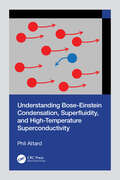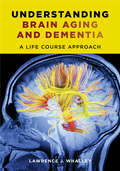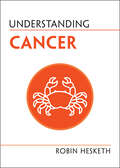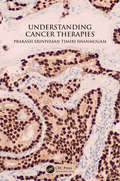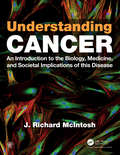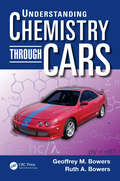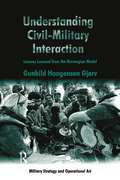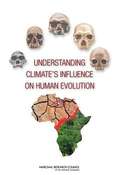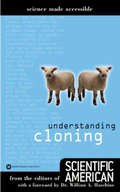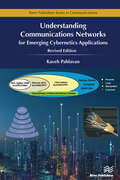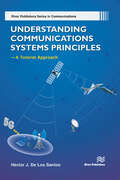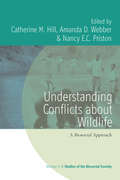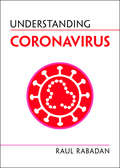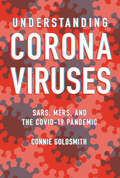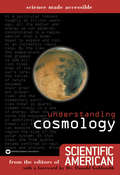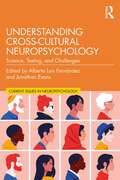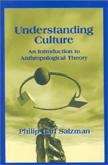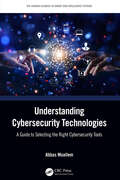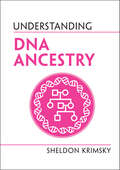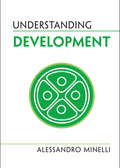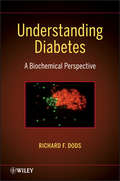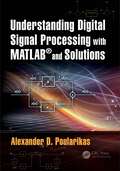- Table View
- List View
Understanding Bose-Einstein Condensation, Superfluidity, and High-Temperature Superconductivity
by Phil AttardBose-Einstein condensation, superfluidity, and superconductivity are quantum mechanics made visible. They mark the boundary between the classical and the quantum worlds, and they show the macroscopic role of quantum mechanics in condensed matter.This book presents these phenomena in terms of particles, their positions, and their momenta, giving a concrete visualisation and description that is not possible with traditional wave functions. A single approach that bridges the classical-quantum divide provides new insight into the role of particle interactions in condensation, the nature of collisions in superfluid flow, and the physical form of Cooper pairs in high-temperature superconductors.High-temperature superconductivity is explored with quantum statistical mechanics, which links it to Bose-Einstein condensation. Identifying a new mechanism for Cooper pairing, this explains the differences between the low- and high-temperature superconducting regimes and the role of the molecular structure of the conductor.The new perspective offered by this book on Bose-Einstein condensation, superfluidity, and high-temperature superconductivity gives particle-based explanations as well as mathematical and computational methods for these macroscopic quantum phenomena so that readers understand the role of particle interactions and structure in the physics of these phenomena.This book will appeal to undergraduate and graduate students, lecturers, academics, and scientific researchers in the fields of Bose-Einstein condensation and condensates, superfluidity, and superconductivity. It will also be of interest to those working with thermodynamics, statistical mechanics, statistical physics, quantum mechanics, molecular dynamics, materials science, condensed matter physics, and theoretical chemistry.Key Features:· Explores Bose-Einstein condensation with new evidence for multiple condensed states and novel Monte Carlo simulations for interacting bosons· Establishes the thermodynamic nature of condensed bosons from an analysis of fountain pressure measurements, including that they carry energy and entropy, and the thermodynamic principle of superfluid flow· Derives equations of motion for condensed bosons, and performs molecular dynamics simulations of the viscosity with molecular trajectories that give rise to superfluidity· Identifies the mechanism for electron pairing in high-temperature superconductivity
Understanding Brain Aging and Dementia: A Life Course Approach
by Lawrence WhalleyThe life course method compares an individual's long-life and late-life behaviors to gauge one's mental decay. Arguing the life course approach is the best and simplest model for tracking mental development, Lawrence J. Whalley unlocks the mysteries of brain functionality, illuminating the processes that affect the brain during aging, the causes behind these changes, and effective coping strategies. Whalley identifies the genetic factors that determine the pace of aging and the behaviors, starting in childhood, that influence how we age. Through vignettes, charts, and tables, he composes an accessible book for patients, family members, and caretakers struggling to make sense of a complex experience.
Understanding Cancer (Understanding Life)
by Robin Hesketh1 in 2 of us will develop cancer at some point in our lives and yet many of us don't understand how cancers arise. How many different kinds of cancer are there? What treatments are available? What does the future hold in terms of developing new therapies? This book demystifies cancer by explaining the underlying cell and molecular biology in a clear and accessible style. It answers the questions commonly asked about cancer such as what causes cancer and how cancer develops. It explains how DNA makes proteins and how mutations can corrupt those proteins. It also gives an overview of current therapies and how treatments may advance over the next decades, as well as explaining what actions we can take to help prevent cancer developing. Understanding Cancer is an accessible and engaging introduction to cancer biology for any interested reader.
Understanding Cancer Therapies
by Prakash Srinivasan Timiri ShanmugamThis book is an introduction to cancer treatment, the basics of radio- and chemotherapy, drug actions, the eradication of cancer cells, and the origins and persistence of pharmacological and toxicological effects of drugs. It further provides ideas for research based on knowledge of cancer metastasis, invasive and molecular pathways, and diagnosis and treatment. Many of the adaptive features of cancer biology, clinical features, pathology and treatment are reviewed. In addition to introducing the major themes and theories, the book also advances the current discussion by moving beyond explanations for clinical implementation. Key Selling Features: Reviews basic cancer treatments Summarizes chemotherapies Discusses radiotherapies Examines pharmacological and toxicological approaches to treatment Introduces oncological drug development
Understanding Cancer: An Introduction to the Biology, Medicine, and Societal Implications of this Disease
by Richard Mcintosh/Mcd BiologyUnderstanding Cancer is a brand-new undergraduate textbook that uses simple language and well-chosen examples to explain the biological processes that underlie cancer and inform our methods for the diagnosis and treatment of this disease. The book has been carefully designed to provide key information relevant for students seeking a broad and accessible introduction to the cancer problem, even if they have no prior training in biology or chemistry.
Understanding Chemistry through Cars
by Geoffrey M. Bowers Ruth A. BowersAs the car anticipates its dance around the racetrack, the engine growls and pops, and all senses become immersed in the smell of exhaust vapors and the sounds of raw speed and excitement. As it turns out, these also are the sights, sounds, and smells of chemistry! The car is a great example of an everyday device with an abundance of chemistry hidi
Understanding Civil-Military Interaction: Lessons Learned from the Norwegian Model (Military Strategy and Operational Art)
by Gunhild Hoogensen GjørvA novel examination of civil-military interaction in particular between militaries and humanitarian actors, in light of the so-called 'Norwegian model' that espouses a clear divide between political and humanitarian (or military and civilian - the model is in fact unclear) actors, while maintaining a tight coordination between them. The Norwegian government has significantly reduced their own military's capacity in the field of civil-military interaction, raising the question as to whether knowledge and skills in this field are necessary. Using a multi-actor security framework, this book examines whether or not the Norwegian government is correct in its assumptions (about both the model and civil-military knowledge amongst military personnel) and concludes that the Norwegian model is a well-meaning but inefficient and problematic model in reality. Although the case study focuses on Norway, the lessons learned are relevant to all nations engaged in civil-military operations.
Understanding Climate (Discover Meteorology)
by Megan Cooley PetersonSome climates are dry and some are wet. Some are cold and some are warm. But those words can describe weather too. Learn the difference between weather and climate. Find out how landforms and location can influence weather patterns.
Understanding Climate Anxiety (BPS Ask The Experts in Psychology Series)
by Geoff BeattieHow should we react to climate anxiety? This accessible book discusses anxiety and other emotions brought on by climate change, examining what climate anxiety is, why it is becoming so prevalent and how it differs from other types of anxiety.Written by an expert psychologist, the book examines why climate anxiety is developing so rapidly, particularly in younger people. It looks at how it can manifest differently—sometimes as hopelessness or despair, and sometimes as anger which can serve as a catalyst for action. The book dives into the nuance around climate anxiety, questioning what we can do about it or whether climate anxiety should be pathologized at all, given the very real threat of climate change. It considers cognitive biases that underlie information processing and discusses how politics and interest groups affect people’s views. Seeking to understand the polarisation that occurs around this topic, the book suggests how we might alleviate climate anxiety without minimising serious concern about climate change.This highly topical book will be of great interest to students of psychology, environmental science and social science. It will also be of interest to psychologists, mental health professionals and climate communicators, as well as anyone interested in learning more about climate anxiety.
Understanding Climate's Influence on Human Evolution
by National Research Council of the National AcademiesThe hominin fossil record documents a history of critical evolutionary events that have ultimately shaped and defined what it means to be human, including the origins of bipedalism; the emergence of our genus Homo; the first use of stone tools; increases in brain size; and the emergence of Homo sapiens, tools, and culture. The Earth's geological record suggests that some evolutionary events were coincident with substantial changes in African and Eurasian climate, raising the possibility that critical junctures in human evolution and behavioral development may have been affected by the environmental characteristics of the areas where hominins evolved. Understanding Climate's Change on Human Evolution explores the opportunities of using scientific research to improve our understanding of how climate may have helped shape our species. Improved climate records for specific regions will be required before it is possible to evaluate how critical resources for hominins, especially water and vegetation, would have been distributed on the landscape during key intervals of hominin history. Existing records contain substantial temporal gaps. The book's initiatives are presented in two major research themes: first, determining the impacts of climate change and climate variability on human evolution and dispersal; and second, integrating climate modeling, environmental records, and biotic responses. Understanding Climate's Change on Human Evolution suggests a new scientific program for international climate and human evolution studies that involve an exploration initiative to locate new fossil sites and to broaden the geographic and temporal sampling of the fossil and archeological record; a comprehensive and integrative scientific drilling program in lakes, lake bed outcrops, and ocean basins surrounding the regions where hominins evolved and a major investment in climate modeling experiments for key time intervals and regions that are critical to understanding human evolution.
Understanding Cloning
by Editors of Scientific AmericanDrawn from the pages of Scientific American and collected here for the first time, this work contains updated and condensed information, made accessible to a general popular science audience, on the subject of cloning.
Understanding Commanders' Information Needs for Influence Operations
by Eric V. Larson Brian Nichiporuk Dalia Dassa Kaye Forrest E. Morgan Richard E. DarilekDocuments a study whose goals were to develop an understanding of commanders' information requirements for cultural and other "soft" factors in order to improve the effectiveness of combined arms operations, and to develop practical ways for commanders to integrate information and influence operations activities into combined arms planning/assessment in order to increase the usefulness to ground commanders of such operations.
Understanding Communications Networks – for Emerging Cybernetics Applications
by Kaveh PahlavanInformation networking has emerged as a multidisciplinary diversified area of research over the past few decades. From traditional wired telephony to cellular voice telephony and from wired access to wireless access to the Internet, information networks have profoundly impacted our lifestyles as they have undergone enormous growth. To understand this technology, students need to learn several disciplines and develop an intuitive feeling of how they interact with one another. To achieve this goal, the book describes important networking standards, classifying their underlying technologies in a logical manner and gives detailed examples of successful applications.The emergence of wireless access and dominance of the Ethernet in LAN technologies has shifted the innovations in networking towards the physical layer and characteristics of the medium. This book pays attention to the physical layer while we provide fundamentals of information networking technologies which are used in wired and wireless networks designed for local and wide area operations. The book provides a comprehensive treatment of the wired IEEE802.3 Ethernet, and Internet as well as ITU cellular 2G-6G wireless networks, IEEE 802.11 for Wi-Fi, and IEEE 802.15 for Bluetooth, ZigBee and ultra-wideband (UWB) technologies. The novelty of the book is that it places emphasis on physical communications issues related to formation and transmission of packets and characteristics of the medium for transmission in variety of networks.Material presented in the book will be beneficial for students of Electrical and Computer Engineering, Computer Science, Robotics Engineering, Biomedical Engineering, or other disciplines who are interested in integration of navigation into their multi-disciplinary projects. The book provides examples with supporting MATLAB codes and hands-on projects throughout to improve the ability of the readers to understand and implement variety of algorithms.
Understanding Communications Systems Principles—A Tutorial Approach
by Héctor J. SantosWireless communications and sensing systems are nowadays ubiquitous; cell phones and automotive radars typifying two of the most familiar examples. This book introduces the field by addressing its fundamental principles, proceeding from its very beginnings, up to today's emerging technologies related to the fifth-generation wireless systems (5G), Multi-Input Multiple Output (MIMO) connectivity, and Aerospace/Electronic Warfare Radar. The tone is tutorial. Problems are included at the end of each chapter to facilitate the understanding and assimilation of the material to electrical engineering undergraduate/graduate students and beginning and non-specialist professionals. Free temporary access to Keysight's SystemVue system simulation is provided to further enhance reader learning through hands-on tutorial exercises.Chapter 1 introduces wireless communications and sensing and in particular how curiosity-driven scientific research led to the foundation of the field. Chapter 2 presents a brief introduction to the building blocks that make up wireless systems. Chapter 3 focuses on developing an understanding of the performance parameters that characterize a wireless system. Chapter 4 deals with circuit topologies for modulation and detection. In chapter 5 we cover the fundamental transmitter and receiver systems architectures that enable the transmission of information at precise frequencies and their reception from among a rather large multitude of other signals present in space. Chapter 6 introduces 5G, its motivation, and its development and adoption challenges for providing unprecedented levels of highest speed wireless connectivity. Chapter 7 takes on the topic of MIMO, its justification and its various architectures. Chapter 8 addresses the topic of aerospace/electronic warfare radar and finally Chapter 9 presents three Tutorials utilizing the SystemVue simulation tool.
Understanding Conflicts about Wildlife: A Biosocial Approach (Studies of the Biosocial Society #9)
by Catherine M. Hill Amanda D. Webber Nancy E. C. PristonConflicts about wildlife are usually portrayed and understood as resulting from the negative impacts of wildlife on human livelihoods or property. However, a greater depth of analysis reveals that many instances of human-wildlife conflict are often better understood as people-people conflict, wherein there is a clash of values between different human groups. Understanding Conflicts About Wildlife unites academics and practitioners from across the globe to develop a holistic view of these interactions. It considers the political and social dimensions of 'human-wildlife conflicts' alongside effective methodological approaches, and will be of value to academics, conservationists and policy makers.
Understanding Coronavirus (Understanding Life)
by Raul RabadanSince the identification of the first cases of the coronavirus in December 2019 in Wuhan, China, there has been a significant amount of confusion regarding the origin and spread of the so-called 'coronavirus', officially named SARS-CoV-2, and the cause of the disease COVID-19. Conflicting messages from the media and officials across different countries and organizations, the abundance of disparate sources of information, unfounded conspiracy theories on the origins of the newly emerging virus and the inconsistent public health measures across different countries, have all served to increase the level of anxiety in the population. Where did the virus come from? How is it transmitted? How does it cause disease? Is it like flu? What is a pandemic? What can we do to stop its spread? Written by a leading expert, this concise and accessible introduction provides answers to the most common questions surrounding coronavirus for a general audience.
Understanding Coronaviruses: SARS, MERS, and the COVID-19 Pandemic
by Connie GoldsmithWhile many scientists believed influenza would cause the next great pandemic, no one was prepared for the new strain of coronavirus that appeared in 2019. SARS-CoV-2, the virus that causes COVID-19, has infiltrated every country and put global public health and the economy at risk. Health-care systems have been pushed to the limit as protective gear, life-saving equipment, tests, and vaccines are scarce and in high demand. From the initial infection to the widespread impact on daily life, Understanding Coronaviruses examines the intricacies of SARS-CoV-2 and COVID-19 and how they compare to previous viruses and pandemics.
Understanding Cosmology
by Scientific AmericanWhat is the true nature of the universe and its ultimate fate? Drawing on ground-breaking observations, cosmologists have come up with startling theories presented in this collection. Issues explored include: The creation and fate of the universe, and the evolution of cosmology as a science.
Understanding Cross-Cultural Neuropsychology: Science, Testing and Challenges (Current Issues in Neuropsychology)
by Alberto Luis FernándezUnderstanding Cross-Cultural Neuropsychology thoroughly examines the meaning of culture in the context of neuropsychology, focusing on the fundamental neuroscience underlying how different aspects of culture influence neuropsychological test performance, and how that is related to brain function. It explores in detail the relationship between brain activity and culture, and the influence of various cultural, educational, and linguistic factors on neuropsychological test performances across various cognitive domains. Written by leadings researchers in cross-cultural neuropsychology, the book first introduces the basic concepts in the field. It goes on to focus on the influence of cultural variables on specific domains of cognition, including perception, attention, memory, language, and executive functions. It also explores the implications of cross-cultural neuropsychology in practice, including a focus on test adaptation, the use of interpreters, the influence of acculturation, and the practice of neuropsychological rehabilitation in different cultural settings. This book is essential reading for neuropsychologists and related practitioners working with culturally diverse clients, who need a good grasp of the cultural impacts on neuropsychological test performance when assessing clients from different cultural, linguistic, and educational backgrounds. It is also valuable for neuropsychologists in countries around the world who need a means of understanding the ways in which their culture impacts the performances of their clients on tests, which have been mostly developed in the U.S. or other Western cultures.
Understanding Culture: An Introduction to Anthropological Theory
by Philip Carl SalzmanSalzman presents anthropological theories with admirable balance and restraint. He makes a case for each theory, offering no criticism until the final chapter in which he offers a brief critique of each.
Understanding Cybersecurity Technologies: A Guide to Selecting the Right Cybersecurity Tools (The Human Element in Smart and Intelligent Systems)
by Abbas MoallemCyberattacks on enterprises, government institutions, and individuals are exponentially growing. At the same time, the number of companies, both small and large, offering all types of solutions has been increasing too. Since companies rely on technological solutions to protect themselves against cyberattacks, understanding and selecting the right solutions among those offered presents a significant challenge for professionals, company executives, and newcomers to the cybersecurity field.FEATURES Presents descriptions for each type of cybersecurity technology and their specifications Explains applications, usages, and offers case studies to enhance comprehension Offers an easy-to-understand classification of existing cybersecurity technologies Provides an understanding of the technologies without getting lost in technical details Focuses on existing technologies used in different solutions, without focusing on the companies that offer these technologies This book is intended to help all professionals new to cybersecurity, students, and experts to learn or educate their audiences on the foundations of the available solutions.
Understanding DNA Ancestry (Understanding Life)
by Sheldon KrimskyDNA ancestry companies generate revenues in the region of $1bn a year, and the company 23andMe is said to have sold 10 million DNA ancestry kits to date. Although evidently popular, the science behind how DNA ancestry tests work is mystifying and difficult for the general public to interpret and understand. In this accessible and engaging book, Sheldon Krimsky, a leading researcher, investigates the methods that different companies use for DNA ancestry testing. He also discusses what the tests are used for, from their application in criminal investigations to discovering missing relatives. With a lack of transparency from companies in sharing their data, absent validation of methods by independent scientists, and currently no agreed-upon standards of accuracy, this book also examines the ethical issues behind genetic genealogy testing, including concerns surrounding data privacy and security. It demystifies the art and science of DNA ancestry testing for the general reader.
Understanding Development (Understanding Life)
by Alessandro MinelliDevelopmental biology is seemingly well understood, with development widely accepted as being a series of programmed changes through which an egg turns into an adult organism, or a seed matures into a plant. However, the picture is much more complex than that: is it all genetically controlled or does environment have an influence? Is the final adult stage the target of development and everything else just a build-up to that point? Are developmental strategies the same in plants as in animals? How do we consider development in single-celled organisms? In this concise, engaging volume, Alessandro Minelli, a leading developmental biologist, addresses these key questions. Using familiar examples and easy-to-follow arguments, he offers fresh alternatives to a number of preconceptions and stereotypes, awakening the reader to the disparity of developmental phenomena across all main branches of the tree of life.
Understanding Diabetes
by R. F. DodsA clear explanation of the cause, diagnosis, and treatment of diabetesWritten for a broad range of readers, including students, researchers, policymakers, health care providers, and diabetes patients and caregivers, this book explains the underlying biochemistry and physiology of diabetes mellitus. Each chapter contains a glossary that defines key terms, a summary that highlights essential concepts discussed in each section of the chapter, as well as a set of simple problems to help readers gain a richer and deeper understanding of diabetes, from its history to treatment options.Understanding Diabetes begins with an overview of the disease, its worldwide prevalence and cost, and its connection to the global obesity epidemic. The author then explores the history of diabetes, including the first documented description of the disease dating back to 3400 BCE in Ancient Egypt. The next chapter, A Glucose Metabolism Primer, sets forth the pathways for the metabolism of glucose. Next, the book covers:Regulation of glucose metabolism and glucose metabolism gone wrongDiabetes classification systemDiagnosis, including current laboratory testsComplications, such as retinopathy, neuropathy, and cardiovascular diseaseHereditary transmissionPrevention and treatment, including emerging researchAlthough a cure has still not been found, this book demonstrates that researchers are continuing to make major breakthroughs on all fronts in the fight against diabetes, including a better understanding of its causes and an improved ability to diagnose and treat the disease.
Understanding Digital Signal Processing with MATLAB and Solutions (The Electrical Engineering and Applied Signal Processing Series)
by Alexander D. PoularikasThe book discusses receiving signals that most electrical engineers detect and study. The vast majority of signals could never be detected due to random additive signals, known as noise, that distorts them or completely overshadows them. Such examples include an audio signal of the pilot communicating with the ground over the engine noise or a bioengineer listening for a fetus’ heartbeat over the mother’s. The text presents the methods for extracting the desired signals from the noise. Each new development includes examples and exercises that use MATLAB to provide the answer in graphic forms for the reader's comprehension and understanding.
